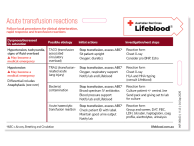Don’t have an account?
Select the donation type you’d like to make
In order to avoid transfusion mistakes, a correctly labelled pretransfusion blood sample must be collected from the intended recipient.
The majority of ABO mismatch transfusion reactions are due to patient misidentification or sample labelling errors.
Each health service must have policies and procedures in place for accurate patient identification and sample collection.
When introducing new technologies that change work flows, such as the introduction of electronic medical records, health services should process map critical tasks such as pretransfusion sample collection to ensure safe sampling techniques.
Blood samples that do not conform will be discarded by the Transfusion Service Provider.
Recommended collection procedure
- Only bleed one patient at a time.
- Never pre-label sample collection tubes.
- Ask the patient (where possible) to state/spell their full name and date of birth, and check these details along with the hospital unique identification number against the identification wrist band if available.
- A family member/carer can assist in verifying patient information if the patient is unable to do so themselves.
- Check that the above details are identical to the details on the request form.
- Label the sample tubes immediately after collection and before leaving the patient with the following details:
- patient’s surname and given name in full
- unique patient identification number and/or date of birth, and
- date and time of collection.
- Confirm that the blood sample, request form and patient details all match.
- Sign/initial both the blood sample and the request form to verify patient identification.
Compatibility testing
Compatibility testing is important to prevent transfusion of incompatible donor red cells that might result in a haemolytic transfusion reaction.
A group and screen (also known as group and hold) includes the following:
- confirmation that patient details on the blood sample and request form are identical
- the checking of historical information on the patient such as previous blood group, previous transfusion and obstetric history
- ABO and RhD typing of the patient's red cells
- antibody screen to detect antibodies in patient's plasma
- identification of red cell antibodies (performed if positive antibody) screen detected, and
- crossmatching appropriate donor red cells.
Crossmatch
Crossmatching is used to confirm compatibility between the patient's blood (plasma) and the donor red cells. This may be performed by either serological or electronic methods.
Serological crossmatch
- Indirect antiglobulin technique (IAT).
- Generally used when crossmatching for patients with clinically significant IgG antibodies.
- Patient's plasma is incubated with donor red cells and tested.
- Immediate spin crossmatch.
- Designed to detect ABO incompatibilities between donor red cells and recipient plasma.
- Only used if patient currently has no clinically significant antibodies, and there’s no history of clinically significant antibodies.
- Patient's plasma is tested against donor red cells.
Non-serological crossmatch
- Electronic crossmatch.
- ABO compatibility of patient and donor red cells is checked by the laboratory information system (LIS) with no serological crossmatch tests needing to be performed.
- Only used if patient currently has no clinically significant antibodies, and there’s no history of clinically significant antibodies.
- Allow red cells to be issued with minimal delay once blood group and antibody screen completed.
- Specific criteria must be met in order to utilise electronic crossmatching (refer to ANZSBT guidelines).
The 72 hour for sample validity
- Sample validity refers to the period when a pretransfusion sample may be held for testing and used to provide crossmatched blood.
- Sample validity period depends on the patient's transfusion and obstetric history. Red cell antibodies can rapidly appear in response to stimulation by transfused red cells or as a result of pregnancy.
- If the patient has been transfused with red cells, or is currently (or has been) pregnant in the 3 months preceding pretransfusion sample collection, the sample will have a validity of 72 hours. This is known as the 72-hour rule.
- A new sample will need to be collected once 72 hours elapses if further transfusion is required.
- Longer expiry times are often applied if the patient does not have a history of transfusion or pregnancy.
- Contact your Transfusion Service Provider for their policy on sample retention.




